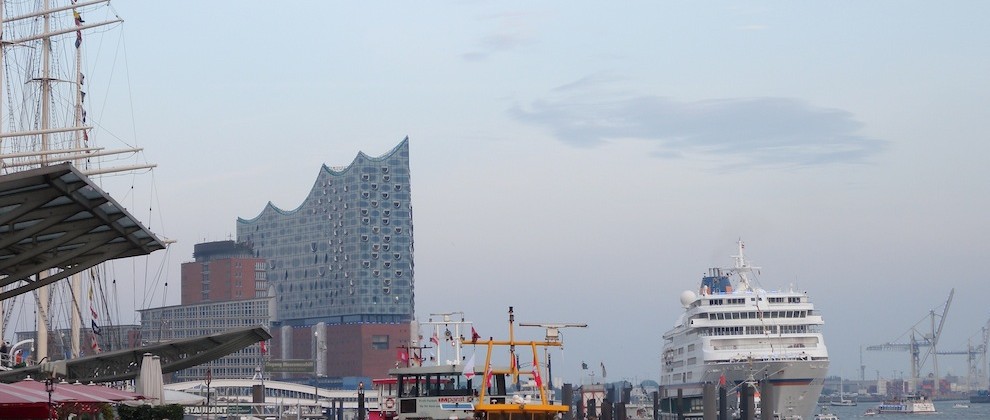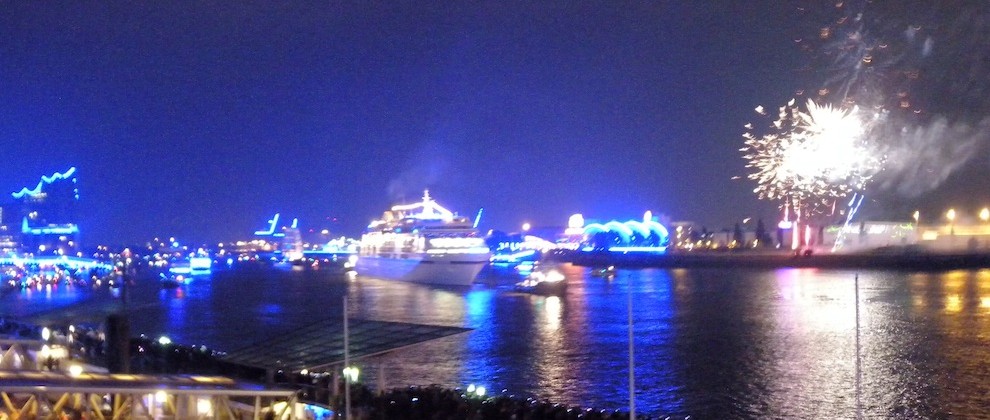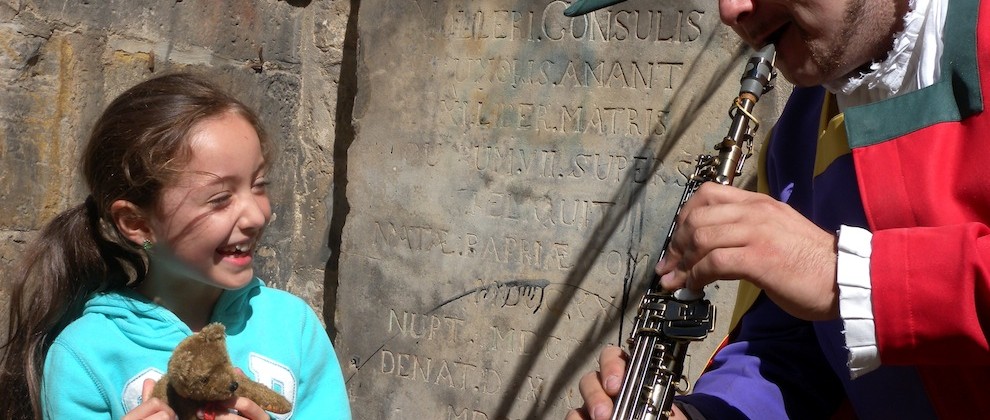
* November 9 marks the anniversary of the fall of the Berlin Wall. That’s why, this weekend, I’m revisiting a story based on a school trip when I was 16 to the former GDR – East Berlin.
Follow me on Twitter, or subscribe to the RSS, for more update.
Summer 1987.
My best mate Chris and I are let loose on an unsuspecting West Berlin as part of a school trip with Mr. Robson’s A Level German class.
I can still remember the black bread for breakfast in the hostel, shopping for souvenirs on the Kurfürstendamm and failing miserably to talk to German girls despite several strong, courage-bolstering lagers.
We also spent a day visiting the city’s east, passing through the original Checkpoint Charlie behind the Iron Curtain, where a state-approved tour of East German towerblocks, stony Soviet statues and bland Eastern-block restaurants awaited us.
After a week of cultural immersion we returned home with expanded horizons and the newly cosmopolitan swagger of a bunch of teenagers who had learnt how to order a snakebite ands black in a foreign language.
We’d also caught a little bit of living history. Within two years of our visit, the Berlin Wall had fallen, ending 28 years of German division, and the Cold War had been consigned to history textbooks forever.
Living history
Berlin will host a series of events this summer to mark the 20th anniversary of the fall of the Berlin Wall (the exact anniversary is November 9). I’m back in Berlin for the first time in 22 years to get into the swing of the party with the summer warm-up and to retrace my route around the former East Berlin.
The retro-kitsch reception of Ostel – the GDR-Design-Hostel instantly makes me feel nostalgic for those halcyon summer nights of Mr. Robson’s school trip.
The German Democratic Republic was the name for East Germany under the Communist dictatorship from 1949 to1990 and Ostel, located just behind the Ostbahnhof train hub in the city’s rapidly changing Friedrichshain district, offers a glimpse of life before the fall of the Berlin Wall.
Berlin is big on nostalgia these days. More precisely, it’s big on ‘ostalgie’, nostalgia for life under Communist rule.
First the film Goodbye Lenin sparked the ostalgie movement. Then a series of Cold War-themed shops, such as Friedrichshain’s Intershop 2000, soon followed to celebrate the days of the GDR. Trabant tours of Berlin’s eastern districts then joined them using the original East German-designed cars that were the pride of Germany under communism.
Ostel, with its retro-kitsch fittings, including a picture of the erstwhile East German political leader Erich Honecker on the wall of every room, completes the ostalgie picture for curious tourists and nostalgic German visitors alike.
Fun, not politics
Dropping my bags at the reception, I survey the step-back-in-time aesthetics.
Behind the counter are four clocks telling the time in the Communist outposts of Berlin, Moscow, Beijing and Havana; a chunky, wood-framed TV set is showing a Cuban propaganda film of Fidel Castro’s rallying speeches; and a weighty tome on a museum-piece coffee table features a good young Communist girl in a DayGlo-pink leotard romping through Pop-Gymnastik routine via a series of eye-watering illustrations.
Downstairs, as the evening sun glances off the grey-brick façade of Ostel, I join the hostel’s co-owner, East Berlin-born Daniel Helbig, for a beer in the makeshift beer garden. Daniel was born at nearby Alexanderplatz and just 18 years old when the Berlin Wall fell.
“Most people know the sights of West Berlin but we wanted to show people the real culture of the East,” says Daniel as we perch on deckchairs, sipping East German Radeberger Pilsner.
Daniel and his business partner both come from art backgrounds. They scoured the attics and flea markets of East Berlin for memorabilia and opened Ostel with 39 rooms, one apartment and no prior hotel experience. They have since expanded by renovating eight apartments in an adjoining block to create a rabbit warren of GDR-styled holiday lets.
“We’re not interested in politics. This is just a bit of fun – and our old-age pension,” says Daniel.
“The GDR was a Police state then as the unified Berlin is now. The problems,” he smiles, draining his beer, “are just different.”
Hidden gems
The next morning I’m up early and ready for breakfast.
But Ostel doesn’t do breakfast. Silly me. The stony-faced receptionist instructs me to buy my €4.50 (£4) breakfast coupon and head round the corner to the Treffpunkt café. There I eat a lonely breakfast of lukewarm coffee, bread, cheese and a bullet-like boiled egg while the stereo blasts the Jungle Book soundtrack into the Berlin morning.
A more surreal start to the day is hard to imagine.
After my disappointing breakfast I set off to explore the city’s eastern districts, much of which is still under heavy construction.
The signs of Berlin’s uneasy relationship with ostalgie are everywhere. The sprawling Palace of the Republic, the former East Germany parliament building, has now been demolished. The Bundestag (German parliament) decided in 2008 to start work on reconstructing a royal palace on the site with a museum, cultural centre and library.
The 368m Television Tower on Alexanderplatz, meanwhile, is now enjoying a second life. Berlin’s tallest building was once a symbol of the Communist state but it is today packed with tourists sipping cappuccinos in the top-floor revolving café and musing on the fall of the regime.
I stroll over to the GDR Museum, which tells the story of everyday life in the East via a series of compelling exhibits and newsreel footage.
There are plenty of quirky exhibits, such as recordings of top pop tunes from the day and grainy footage of East German holidaymakers cavorting on Eastern Bloc nudist beaches. But the sinister side of the regime is never far away. The surveillance section, where the desk is piled high with bugging devices once used to spy on ordinary people, is introduced by a sign on the wall.
It warns: ‘The Stasi’s eyes and ears were everywhere. There was nowhere to hide; the society was full of informers.’
Across town at the intersection of Zimmerstrasse and Friedrichstrasse, the rebuilt Checkpoint Charlie has more of a Disneyland feel with souvenir stalls selling fake Russian army hats and Communist kitsch.
The nearby Mauermusuem Haus am Checkpoint Charlie is an altogether more powerful experience, telling the tragic tale of the 200 people who lost their lives attempting to flee across the Berlin Wall. Chris Gueffroy was the last person killed by GDR border guards while trying to escape to the West.
He was shot dead on February 5, 1989 – just a few months before the fall of the Wall.
I finish my circuit on foot back near Ostbanhof at the East Side Gallery, which, at 1.3km, is the longest remaining stretch of the Berlin Wall and now an al fresco art gallery.
Here the iconic image of the then Russian president, Leonard Brezhnev, and the East German leader, Erich Honecker, embracing in a show of Cold War unity, remains the chilling centrepiece.
Around it a series of colourful graffiti and elaborate murals plead for peace and mutual understanding, while the Wall Park Gardens around the back of the wall are home to more fragments of history overgrown with wild flowers.
The East Side Gallery is now the subject of a €2.2m project to protect it from weather, pollution and souvenir hunters armed with chisels. The organisers hope the gallery will be restored to its former glory by the November 9 anniversary.
This is also a good place to pick up a tour in the one of the genuine two-stroke Trabant cars waiting nearby to ferry tourists around the cafes and bars of the newly hip Mitte district formerly at the heart of Berlin’s drab east.
While ostalgie plays on retro design and post-modernist irony, my last visit of the day serves to remind me of the grim reality of life under a harsh regime desperate to survive at any cost.
The Stasi Museum, located in the grim complex of the former Ministry of State Security (better known as the Stasi), was created after the people of Berlin stormed the building in 1989. The archives have since been opened to the public and the names of 6.5m so-called ‘enemies of state’ revealed. It’s an eerie but evocative conclusion to my tour of ostalgie sites.
Complex issue
That night, back at Ostel after a cheap, quick dinner at a Ostbahnhof cafe , I collect my key and head for my shoebox room, a stark and unwelcoming hutch atop six steep, grey-stone flights of stairs.
“Of course there’s no lift,” the receptionist shoots me a withering look when I enquire at reception. “There were no lifts in the GDR.”
I close the door behind me and feel an overwhelming urge to check under the mattress for listening devices. I’m sure the eyes of Erich Honecker, whose picture adorns the wall of every room, are following me.
On the landing outside I find the bathroom I’ll share with three other rooms. It feels very much like a mid-range youth hostel, but it does mercifully have hot water and soft toilet paper.
With little to distract in my room, I head downstairs to the beer garden, where I find Andrew Hammond, a US-born law professor at the University of Düsseldorf, who is staying at Ostel while attending a conference.
“I’m attracted to this place by the combination of cheap rooms and the insight into a bygone world with the charming elegance of GDR design,” he tells me as we sup beers by moonlight and the receptionist files her nails nonchalantly.
“The GDR was the best functioning Communist state and a lot of people still identify with its ideas. But Ostalgie is a complex issue,” he adds.
“You can’t make something frivolous out of a chilling dictatorship.”
With the ostalgie movement now in full bloom, the contradictions between East and West Berlin will provide the historical backdrop to this year’s anniversary events.
Alexanderplatz is currently hosting the open-air exhibition ‘Peaceful Revolution 1989/90’, a free, 24-hour installation November 14. It documents the peaceful revolution leading to Germany’s reunification and acknowledges the protest by civil rights activists in the spring of 1989, which led to the nationwide demonstration movement in the autumn and marked the beginning of the end for the Berlin Wall.
Another installation, ‘Focuses of New Berlin – 20 years of a changing city’ will shift around areas of the city every 14 days from now until November. It highlights the city’s development as a centre for tourism with information, events and a meeting point for city tours exploring the changing face of Berlin’s sprawling districts.
Looking ahead, Berlin’s museums will open all night long on August 29 this year and anniversary of the fall of the Berlin Wall itself will be marked by a huge street party at the Brandenburg Gate on Monday, November 9th.
From my short time here I can see how Berlin has changed immeasurably in the last 22 years – as have I. But, as I ride the wave of ostalgie and look forward to summer of modern history-inspired parties, it feels great to be back in Berlin and practicing my schoolboy German once again.
Mr. Robson would, I hope, be proud of me.
* This story first appeared in Real Travel magazine in 2008. Liked this? Try Following the Pied Piper Trail in Hamelin.
Post your comments below.



